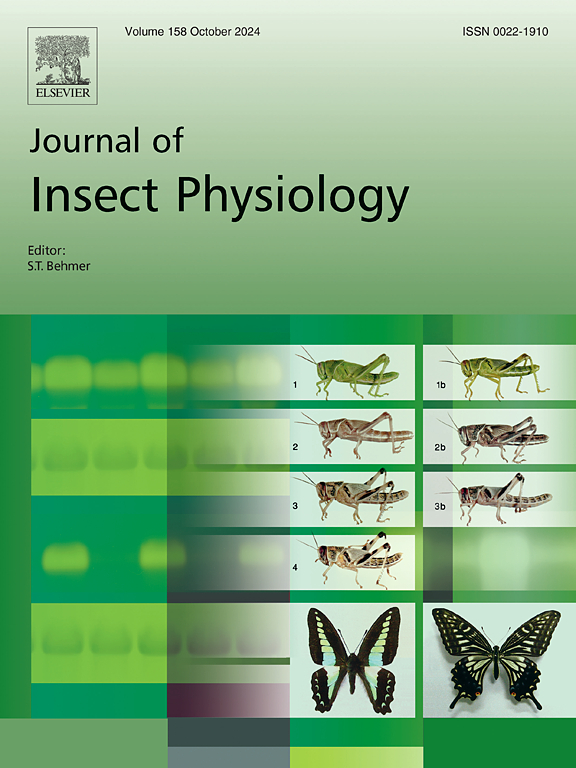膜翅目:小茧蜂(Cotesia vestalis)寄生成功或不成功对几种寄主蛾睾丸发育的影响
IF 2.3
2区 农林科学
Q1 ENTOMOLOGY
引用次数: 0
摘要
寄生蜂的寄生会改变寄主昆虫的生理和行为。本文研究了不同寄生方式对几种蛾类个体寄主发育和睾丸生长的影响。孤生寄生蜂维斯塔蜂(Cotesia vestalis,膜翅目:小蜂科)主要寄生小菜蛾(小菜蛾,鳞翅目:小菜蛾科),但其寄主范围较广。先前的研究证实了小菜蛾、分离密蛾(夜蛾科)和棉铃虫(夜蛾科)的成功寄生,而对黑斑夜蛾(夜蛾科)、黑斑夜蛾(夜蛾科)、白斑夜蛾(夜蛾科)和巴西夜蛾(夜蛾科)的不成功寄生。在本研究中,除白蛉外,所有被寄生寄主的睾丸均发育良好。与未被寄生的对照组相比被抑制或减少。值得注意的是,除了小菜蛾的末龄幼虫外,被寄生寄主的睾丸在被寄生后表现出一定程度的生长,这种生长因种而异,与蜕皮无关。这些发现表明,无论寄生是否成功,寄生都会抑制或减少睾丸的发育。在寄生不成功的情况下,睾丸发育减少的潜在机制在外皮甾体信号和寄生过程的背景下进行了讨论。本文章由计算机程序翻译,如有差异,请以英文原文为准。

Effects of successful or unsuccessful parasitism by the solitary endoparasitoid wasp Cotesia vestalis (Hymenoptera: Braconidae) on the testis development in several host moth species
Parasitism by a parasitoid wasp alters the physiology and behavior of its host insects. This study investigated the effects of successful and unsuccessful parasitization on individual host development and testis growth in several moth species. Although the solitary koinobiont endoparasitoid wasp, Cotesia vestalis (Hymenoptera: Braconidae), primarily parasitizes the diamondback moth (Plutella xylostella, Lepidoptera: Plutellidae), its host range is relatively broad. Previous research confirmed successful parasitization of P. xylostella, Mythimna separata (Noctuidae), and Helicoverpa armigera armigera (Noctuidae), whereas attempts to parasitize Spodoptera exigua (Noctuidae), Palpita nigropunctalis (Piralidae), Aedia leucomelas (Nocuidae), and Mamestra brasiccae (Noctuidae) were unsuccessful. In this study, testis development in all parasitized hosts, except for A. leucomelas. was suppressed or reduced compared to the unparasitized controls. Notably, testes in parasitized hosts exhibited some degree of growth after parasitization—varying by species and occurring independently of ecdysis—except in final instar larvae of P. xylostella. These finding suggest that parasitism suppresses or reduce testis development regardless of whether parrasistization is successful. The potential mechanisms underlying a reduction of testis development in unsuccessful parasitization are discussed in the context of ecdysteroid signaling and the parasitic process.
求助全文
通过发布文献求助,成功后即可免费获取论文全文。
去求助
来源期刊

Journal of insect physiology
生物-昆虫学
CiteScore
4.50
自引率
4.50%
发文量
77
审稿时长
57 days
期刊介绍:
All aspects of insect physiology are published in this journal which will also accept papers on the physiology of other arthropods, if the referees consider the work to be of general interest. The coverage includes endocrinology (in relation to moulting, reproduction and metabolism), pheromones, neurobiology (cellular, integrative and developmental), physiological pharmacology, nutrition (food selection, digestion and absorption), homeostasis, excretion, reproduction and behaviour. Papers covering functional genomics and molecular approaches to physiological problems will also be included. Communications on structure and applied entomology can be published if the subject matter has an explicit bearing on the physiology of arthropods. Review articles and novel method papers are also welcomed.
 求助内容:
求助内容: 应助结果提醒方式:
应助结果提醒方式:


